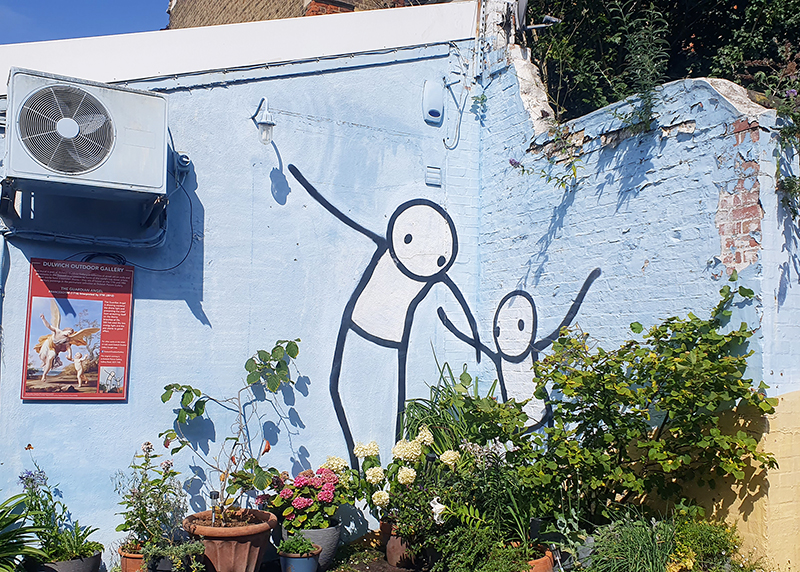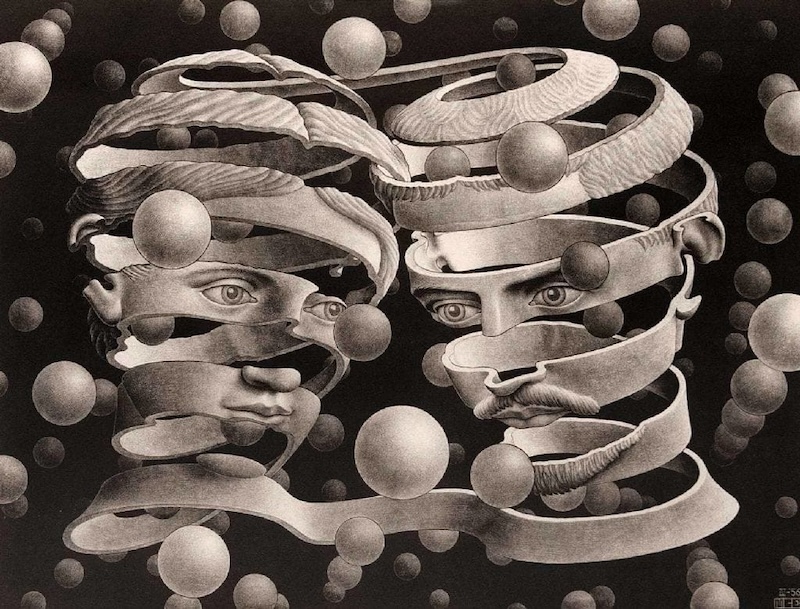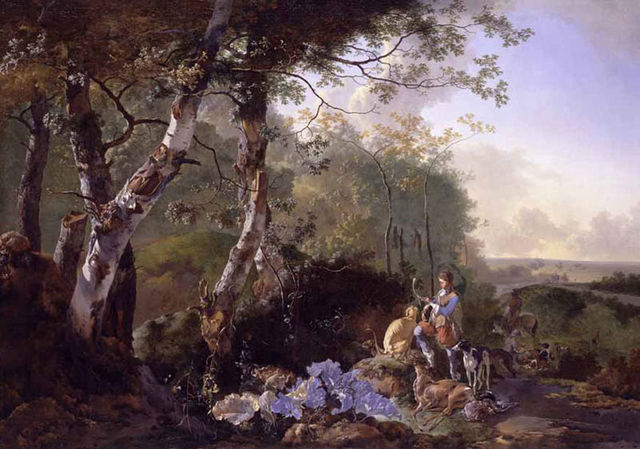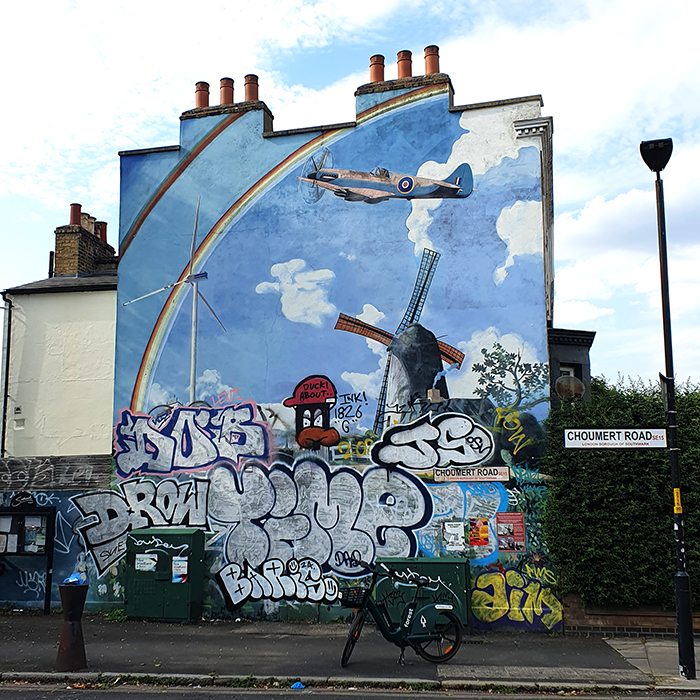One of the hidden gems in London’s street art scene is the Dulwich Outdoor Gallery, an extraordinary collection of murals in Dulwich. These murals, created by some of the world’s most renowned street artists, draw inspiration from 17th and 18th-century paintings housed in the Dulwich Picture Gallery, which is England’s first purpose-built public art gallery.
By blending classical masterpieces with contemporary street styles, these murals enrich street art in London and transform this quiet neighborhood into an immersive artistic space. This project explores the relationship between street art and the continuum of art history, bringing artwork outside the museum and into the streets, thus allowing residents and visitors alike to experience and engage with the gallery’s collection in a more accessible, everyday setting.
Dulwich Street Art Map
Find Dulwich murals in my London google map, featuring not only street art, but also off-the-beaten path spots, alternative cultural venues and not-touristy places to eat and drink like a local.

Street Artists Reinterpret Classical Paintings in Dulwich
For the Dulwich Outdoor Gallery, renowned street artists from around the globe selected paintings from the Dulwich Picture Gallery that personally inspired them and reinterpreted these classical works in their own unique styles. These reinterpretations were then brought to life on the walls and streets surrounding the gallery, blending historical art with contemporary urban expression.
This project began in 2012, sparked by the collaboration between Ingrid Beazley of the Dulwich Picture Gallery and London-based street artist Stik. It further evolved with the launch of the “Baroque The Streets” street art festival in 2013.
While many of the murals created between 2012 and 2014 have since faded or disappeared, as is common with urban art, which is often short-lived, some still remain. A visit to Dulwich is worth the trip, not only to see these stunning surviving murals, which we will delve into in this article, but also to experience the village-like charm of the area.
One of the most elegant and affluent neighborhoods in South-East London, Dulwich retains its village roots, a source of pride for its residents to this day. Dulwich is known for its tree-lined streets filled with Georgian houses, quaint wooden cottages, bistros, cafés, parks, and boutique shops.
When I first explored Dulwich, I was struck by the unique atmosphere of this neighborhood. What captivated me the most was how the Dulwich Outdoor Gallery successfully connected Baroque paintings with contemporary street art. The curatorial work behind the project felt like a bridge across centuries, rooting international artists’ creations in the local context.
These site-specific murals not only celebrate Dulwich’s rich heritage but also bring art outside the traditional gallery walls, allowing residents, Londoners, and visitors to engage with these masterpieces on a personal level—making old paintings feel alive, relevant, and anything but boring.
Discovering the Murals of the Dulwich Outdoor Gallery
Table of Contents
Dulwich Outdoor Gallery: Remi Rough and System (2013)
The first mural you’ll encounter if arriving from East Dulwich station is a captivating collaboration between London-based graffiti artists Remi Rough and System. They masterfully blended two classical paintings, Rembrandt’s “Girl at a Window” (1645) and Poussin’s “The Triumph of David” (1631), into a single, contemporary street art piece. System transformed Rembrandt’s 17th-century girl into a modern figure with a cap, hoodie, and spray cans, while Remi Rough’s sharp lines and colors reflect Poussin’s columns and fabric, creating a vibrant visual dialogue between past and present.
Dulwich Outdoor Gallery: Connor Harrington (2013)

This standout mural in Dulwich by Irish street artist Conor Harrington reinterprets Le Brun’s “Massacre of the Innocents” (1660). Known for his iconic depictions of men in historical attire, Harrington’s pieces focuse on violence and conflict. This mural features aggressive boxers dressed in Regency-era costumes, referencing the period when the Dulwich Picture Gallery opened in 1811. The fighters, rooted in history, continue their symbolic battle across different times and places, reflecting Harrington’s recurring exploration of power, masculinity, and historical tension in his work.

Dulwich Outdoor Gallery: Stik (2012)

London-based street artist Stik reimagined Francescini’s “The Guardian Angel” (1716) in his distinct stick-figure style for one of his many murals for the Dulwich Outdoor Gallery. In this piece, Stik simplifies the divine scene, where the angel protects humanity from the thorny challenges of life. Known for his minimalist figures, Stik’s work often conveys deeper meanings, and his interpretation here reflects his focus on human vulnerability and care, fitting seamlessly with the original theme of divine guidance.

Dulwich Outdoor Gallery: MadC (2014)

In her mural for the Dulwich Outdoor Gallery, German post-graffiti artist MadC reinterpreted Van Dyck’s “Venetia, Lady Digby, on her Deathbed” (1633). Known for her dynamic, large-scale murals, MadC takes the colors and composition of the original painting and recreates them with bold, sweeping strokes. She captures the diagonal white sheet, Lady Digby’s yellowed face and arm, and the blue-black shroud. The pink rose, painted with realistic detail, symbolizes love lost, as Lady Venetia has passed before her time, infusing the piece with both beauty and sorrow.

Dulwich Outdoor Gallery: Faith47 (2014)

In her mural for the Dulwich Outdoor Gallery, South African street artist Faith47 reinterpreted Guido Reni’s “Europa and the Bull” (1640) with her signature emotive and spiritual style. Instead of depicting Zeus as a bull, Faith replaced him with a “guiding bird,” symbolizing the impending abduction. Painted in monochrome, the mural reflects her use of soft, muted tones and flowing lines. Known for addressing themes of transformation and mythology, Faith’s version carries her characteristic depth, evoking both the serenity and tension of Europa’s mythological journey.
Dulwich Outdoor Gallery: Stik (2012)
In this other mural for the Dulwich Outdoor Gallery, Stik reinterprets Van Aelst’s “The Fall of Man” (1520), a scene depicted countless times in art history: the biblical moment when Adam and Eve eat the forbidden fruit from the Tree of Knowledge. Stik’s minimalist figures offer a contemporary take on this classic narrative, where the simplicity of his lines and subtle gestures emphasize the tension between temptation and restraint. This approach allows the timeless story to resonate in a fresh, modern context, inviting reflection on human vulnerability.
Dulwich Outdoor Gallery: Phlegm (2013)

In his mural for the Dulwich Outdoor Gallery, English street artist Phlegm reinterprets Poussin’s “The Triumph of David” (1631) by focusing on a single character from the painting—the trumpeter in the crowd. In classic Phlegm style, he transforms the figure into one of his signature, fantastical characters, blending surrealism and intricacy. Known for his monochromatic palette and elaborate detail, Phlegm’s unique interpretation brings a dreamlike, mythical quality to this historical scene, merging his imaginative world with the classical narrative of Poussin’s work.

Dulwich Outdoor Gallery: ROA (2013)
Belgian street artist ROA is internationally acclaimed for his large-scale, monochromatic murals that depict animals in a raw and realistic manner. For the Dulwich Outdoor Gallery, ROA reinterpreted Pynacker’s “Landscape with Sportsmen and Game” (1665) by honing in on a specific detail: a skinny hunting dog in the act of defecating. By turning the dog around and presenting this unembellished moment, ROA stays true to his style of highlighting the often overlooked or unglamorous aspects of animal life. Such everyday scenes were common subjects in 17th-century genre paintings but can be startling to contemporary audiences. ROA’s mural brings a modern perspective to this classic artwork, emphasizing the natural behaviors that connect all creatures and encouraging viewers to confront the realities of life and nature.
Dulwich Outdoor Gallery: Thierry Noir (2013)

French artist Thierry Noir, famed for his bold, colorful work on the Berlin Wall during the 1980s, reinterpreted Tiepolo’s “Joseph Receives the Ring from Pharaoh” (1733) for the Dulwich Outdoor Gallery. The scene, where Pharaoh gives Joseph his ring, symbolizing his rise to power in Egypt, features half-figures, which perfectly align with Noir’s compositional style. His signature simplified forms and vibrant colors, especially suited to the location near a children’s playground in Dulwich Park, add a playful and modern touch to this historical narrative. Noir also adjusted the spacing between figures to complement the wall’s layout.
Dulwich Outdoor Gallery: Stik (2012)
On the same structure as Thierry Noir’s mural, Stik reinterprets Murillo’s “Three Boys” (1670) on the adjacent wall. Murillo’s original depicts street boys in ragged clothing negotiating for food and drink. In Stik’s version, his signature minimalist figures are also engaged in negotiation, though the subject of their discussion is left open to interpretation. By stripping away details like clothing, gender, ethnicity, and age, Stik focuses on the expressive body language of his figures, allowing viewers to connect with the universal nature of human interaction.
Dulwich Outdoor Gallery: Walter Kershaw (2014)
Walter Kershaw, a pioneering British street artist and muralist, is known for his large-scale murals, particularly on residential and industrial buildings in Greater Manchester since the 1970s. For the Dulwich Outdoor Gallery, Kershaw reinterpreted Van Ruisdael’s “Landscape with Windmills Near Haarlem” (1650), which was reinterpreted by John Constable already in 1831. Walter Kershaw enlarged this small masterpiece, replacing the church with the Dulwich Picture Gallery as a symbol of modern importance, and whimsically added a spitfire, whose propeller echoes the windmill shapes in the original.

Bonus Track: Phlegm in Herne Hill (2016)

A few years after his first mural in Dulwich, Phlegm returned to interpret M.C. Escher’s “Bond of Union” (1956), part of a temporary exhibition at the Dulwich Picture Gallery. Located in Herne Hill, this mural reflects Phlegm’s detailed black-and-white style, perfectly suited for reimagining Escher’s intricate, geometrically complex themes. Both artists share a fascination with surreal, otherworldly landscapes and explore ideas of transformation and interconnectedness. Like Escher, Phlegm’s work blurs the line between reality and imagination, creating visually and conceptually layered pieces that invite viewers into fantastical worlds.

More Murals by Remi Rough in Dulwich, London
Remi Rough, a long-time resident of Dulwich, has painted numerous murals around the area in his signature abstract style, which evolved from his early graffiti lettering. Active since the 1980s as part of South London’s graffiti scene, Rough transitioned to abstract murals in the 2000s.

Dulwich is truly a hidden gem, offering visitors a tranquil escape from the hustle and bustle of London. As you explore its tree-lined streets, don’t miss the opportunity to discover its rich street art scene, stopping at cozy cafés and bistros along the way. It’s the perfect place to unwind and appreciate both art and atmosphere.
Dulwich Street Art Map
Find Dulwich murals in my London google map, featuring not only street art, but also off-the-beaten path spots, alternative cultural venues and not-touristy places to eat and drink like a local.











